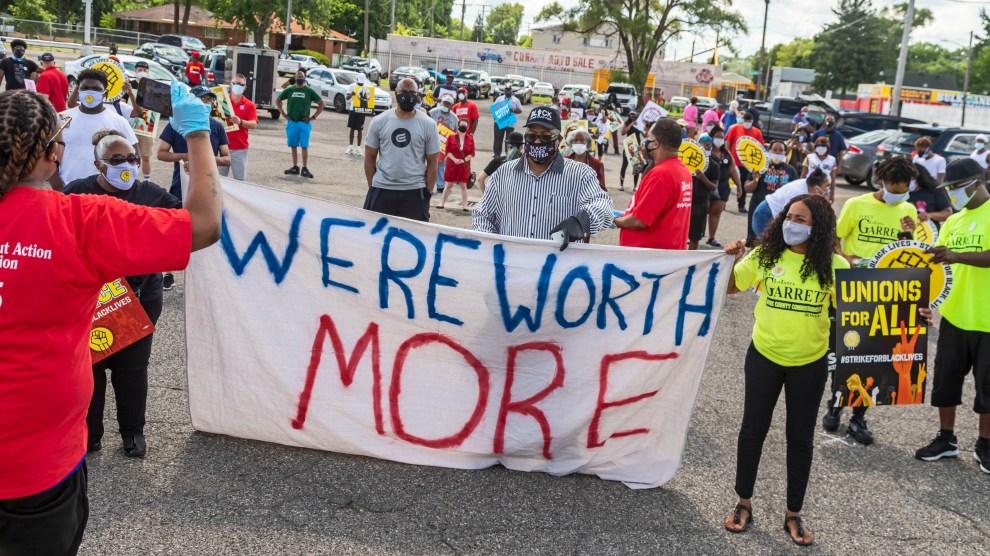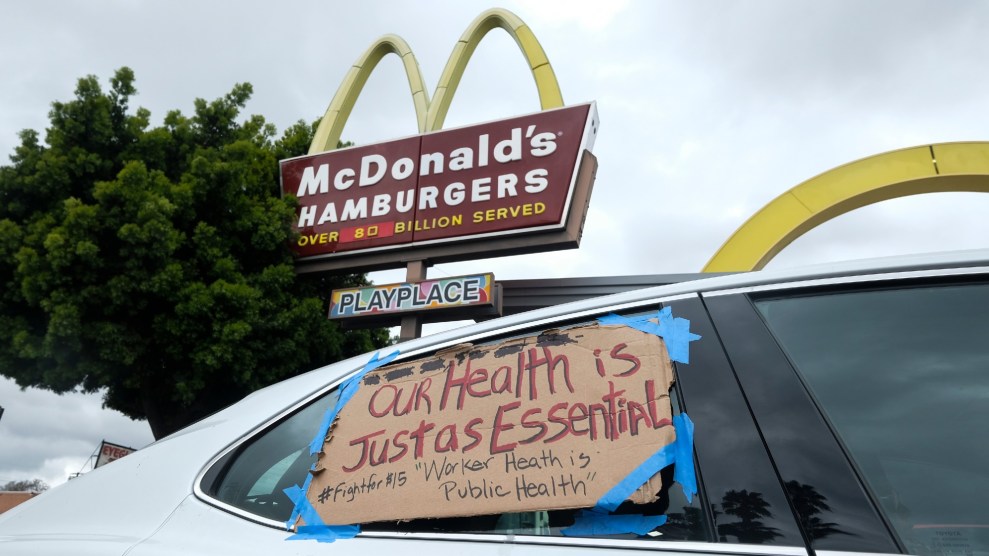
Fast-food workers and supporters rally outside a McDonald's in Detroit in July.Jim West/ZUMA Wire
Working for Walmart or McDonald’s has never been particularly lucrative. But a new report shows just how underpaid employees for these companies are, by revealing how many of them need to lean on government assistance programs as they eke out a living.
Congress’ nonpartisan watchdog, the Government Accountability Office, released a report on Wednesday showing that most adults who receive Medicaid and SNAP (formerly known as food stamps) work full-time jobs but make very little money. The agency wanted to see exactly which companies employ them, so it examined data from 11 states and found that in each one, Walmart was among the top four companies with workers receiving these types of government assistance. McDonald’s was in the top five in at least nine states. Here’s a glimpse of the situation in Georgia, where Walmart workers make up more than 2 percent of all non-elderly and non-disabled workers in the state receiving Medicaid.

A chart from the GAO report
Other big companies that made the watchdog’s lists in multiple states included Target, Amazon, discount retailers Dollar Tree and Dollar General, and fast-food chains like Burger King and Taco Bell. The GAO found that workers enrolled in Medicaid and SNAP were more likely than workers who weren’t enrolled to have jobs in the private sector, especially in the leisure and hospitality industry and the food service industry. “At a time when huge corporations like Walmart and McDonald’s are making billions in profits and giving their CEOs tens of millions of dollars a year, they’re relying on corporate welfare from the federal government by paying their workers starvation wages,” Sen. Bernie Sanders (I-Vt.) said in a statement about the study, which the GAO conducted at his request. “This is morally obscene.”
Sanders said the findings show it’s time to at least double the federal minimum wage, which has stood at just $7.25 an hour since 2009. In the years since, the cost of living has increased about 20 percent, and prices for homes and health care have gone up even more. Plus, the GAO report draws on data from February, before the pandemic unfolded in the United States. Conditions for workers have clearly gotten much worse since then.
Walmart pushed back against the findings of the GAO report. Spokesperson Anne Hatfield said the company is the largest employer in the United States, and that the number of its workers enrolled in government assistance reflected that. “If not for the employment access Walmart and other companies provide, many more people would be dependent on government assistance,” she said in a statement. She added that the company’s starting rate was more than 50 percent higher than the federal minimum wage.
McDonald’s also argued the study’s data was misleading. Spokesperson Morgan O’Marra said the average starting wage at its company-owned restaurants in the United States is more than $10 per hour, higher than the federal minimum wage. (Most McDonald’s restaurants are franchises that aren’t operated by the company.) Last year, McDonald’s announced that it would no longer lobby against efforts to raise minimum wages.
Heather Boushey, who leads a think tank called the Washington Center for Equitable Growth and has been advising President-elect Joe Biden, told the Washington Post that it’s not necessarily a bad thing workers are looking to the government for assistance, as long as the companies who employ them pay their fair share of taxes. Sanders has long pushed for higher taxes on corporations, especially those with huge gaps between the salaries of CEOs and the wages of most employees.
As the pandemic continues, workers are clearly struggling, and there’s been a dramatic increase in the number of families unable to pay rent or put dinner on the table. But big corporations continue to profit. Walmart reported $5.1 billion in net income for the third quarter of 2020, while McDonald’s raked in $1.7 billion. This has only been possible because their employees stayed on the front lines, increasing their risk of contracting the virus, while often not making enough money to afford food and health insurance.












